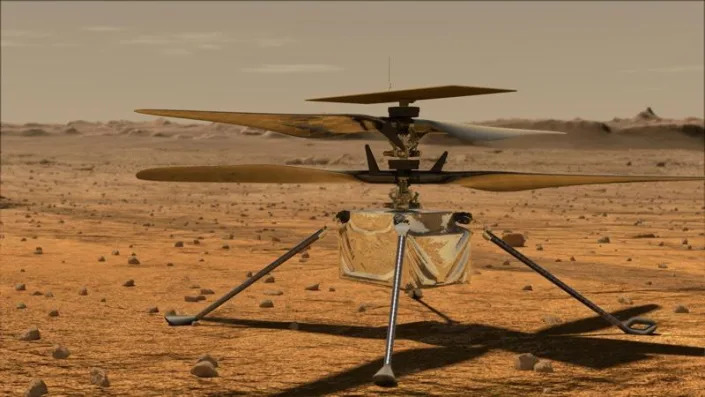 |
| Fig. 1 A Traveler On Mars |
 |
| Fig. 2 A Traveler Within Us |
I. Working Machines
The graphics at Fig. 1 and Fig. 2 show two, yes two, machines; one is the first helicopter-like machine on Mars, and the other depicts a virus-like machine within both humans and animals.
They are both machines, yet the Fig. 2 machine is not characterized that way in the corporate for-profit news media, because they want to characterize viruses as creatures that are out to get us; you know, the typical security-is-us scenario (American Feudalism).
The truth is that we have more machines in us than mars has ever had on it and orbiting above it:
"Molecular machines are tiny energy conversion devices on the molecular-size scale. Whether naturally occurring or synthetic, these
machines are generally more efficient than their macroscale counterparts. They have their own mechanochemistry, dynamics, workspace, and usability and are composed of nature's building blocks: namely proteins, DNA, and other compounds, built atom by atom. With modern scientific capabilities it has become possible to create synthetic molecular devices and interface them with each other. Countless such machines exist in nature, and it is possible to build artificial ones by mimicking nature. Here we review some of the known molecular machines, their structures, features, and characteristics. We also look at certain devices in their early development stages, as well as their future applications and challenges"
(Molecular Machines). To be more specific:
“Our cells, and the cells of all organisms, are composed of molecular machines. These machines are built of component parts, each of which contributes a partial function or structural element to the machine. How such sophisticated, multi-component machines could evolve has been somewhat mysterious, and highly controversial.” Professor Lithgow said.
...
Many cellular processes are carried out by molecular ‘machines’ — assemblies of multiple differentiated proteins that physically
interact to execute biological functions ... Our experiments show that increased complexity in an essential molecular machine evolved because of simple, high-probability evolutionary processes, without the apparent evolution of novel functions. They point to a plausible mechanism for the evolution of complexity in other multi-paralogue protein complexes.
...
The most complex molecular machines are found within cells.
...
Writing in the journal PLoS Pathogens, the team from Queen Mary's School of Biological and Chemical Sciences show how they studied the molecular machine known as the 'type II bacterial secretion system', which is
responsible for delivering potent toxins from bacteria such as enterotoxigenic E. coli and Vibrio cholerae into an infected individual.
Professor Richard Pickersgill, who led the research, said: "Bacterial secretion systems deliver disease causing toxins into host tissue. If we can understand how these machines work, then we can work out how it they might be stopped.""
(On The Origin of the Genes of Viruses). These statements refer to working machines.
II. What About Damaged Machines?
In a recent post I pointed out that there are many viruses that have been extracted from both humans and animals that have 'Siamese Twin' genes within them, i.e. two genes fused into one, but labeled "overlapping genes" (The Coronaviridae - 7).
 |
| Fig. 3 Overlapped genes? |
That is a misnomer and it is bad nomenclature (Good Nomenclature: A Matter of Life and Death).
In a serious accident when two cars are fused together by impact the result is not "overlapping vehicles", it is rightly called a pile of junk (Fig. 3).
This bad nomenclature not only gives new meaning to "junk genes", it also makes me wonder why "they" don't call genetic damage by disaster what it is (One Man's Junk Gene Is Another Man's Treasure Gene?).
The appendix to today's post lists such viruses in various countries (Appendix Link).
III. Damaged Genes That Are Fused
Into Junk Genes Don't Work Anymore
The main hypothesis set forth in this series is that the overuse of chemicals, which causes overkill, by the mass-production-of-animals-for-food industry is spreading pathogens into animals and people via their vast distribution system.
Recently the World Health Organization (WHO) listed that as one possible reality:
"3. Introduction through refrigerated or frozen foods WHO ASSESSMENT: possible"
(National Geographic, 'We still don’t know the origins of the coronavirus'). The damage to genomes is also a reality:
"Cellular fitness relies heavily on the ability of the cell to cope
with mistakes resulting from biological processes being intrinsically imprecise and from exposure to a multitude of endogenous and exogenous
insults. Damaging agents alter the chemical composition and, hence, the function of biomolecules, including DNA, RNA, protein, and lipids.
Nucleic acids are specifically susceptible to chemical damage primarily due to the reactivity of the nitrogen and oxygen atoms of the nucleobase
with a variety of chemicals. These chemical assaults include reactive oxygen species (ROS), ultraviolet light, and alkylating agents. Curiously, certain species of damaged RNAs, typically oxidized, have been linked to a number of neurodegenerative disorders. These observations suggest that the inability of the cell to clear damaged RNAs could contribute to disease or that certain diseases may interfere with cellular handling of damaged RNA.
Unlike naturally occurring modifications of specific nucleotides in rRNA and tRNA, unwanted modification [of nucleotides] resulting from chemical agents typically has deleterious effects on RNA’s function. Specifically, some modifications can prevent base pairing completely, while others alter the base-pairing properties of the modified nucleotide. Consistent with these ideas are recent discoveries showing that chemically damaged RNAs pose significant hurdles to translational fidelity and efficiency. Modifications interfere with the decoding process on the ribosome, whereby codon–anticodon interactions are disrupted and, depending on the type of damage, result in stalling or miscoding."
(The Coronaviridae - 6). That refers to a microbe host ("cell") that when damaged does not replicate genetic material correctly, but the same dynamic can also apply directly to viruses (machines) that are working properly but are then damaged to become pathogens too:
"OLGs are known entities but remain inconsistently reported in viruses of the species Severe acute respiratory syndrome-related coronavirus (subgenus Sarbecovirus; genus Betacoronavirus; Coronaviridae Study Group of the International Committee on Taxonomy of Viruses et al., 2020). For example, annotations of ORF9b and ORF9c are absent or conflicting in SARS-CoV-2 reference genome Wuhan-Hu-1 (NCBI: NC_045512.2) and genomic studies (e.g. Chan et al., 2020; Wu et al., 2020b), and OLGs are often not displayed in genome browsers (e.g. Flynn et al., 2020). Further, ORF3b, an extensively characterized OLG within ORF3a that is present in other species members including SARS-CoV (SARS-CoV-1) (McBride and Fielding, 2012), has sometimes been annotated in SARS-CoV-2 even though it contains four early STOP codons in this virus. Such inconsistencies complicate research, because OLGs may play key roles in the emergence of new viruses."
(The Coronaviridae - 7). Let's point out the OLG reality far and wide then.
IV. Closing Comments
So, let the research continue because if the Dredd Blog hypothesis is correct, the mass-production-of-animals-for-food industry will continue to mass-produce damaged viruses and microbes in food.
The next post in this series is here, the previous post in this series is here.
Time for a 'twofer' (link).
ReplyDeleteAnimal torture to be limited to coffee breaks only (Iowa farmers await fate of California animal cruelty proposition).
ReplyDelete